Walt Disney Company Marketing Analysis
VerifiedAdded on 2020/11/09
|13
|4125
|104
AI Summary
The provided document is an assignment that requires students to analyze Walt Disney Company's marketing strategies, focusing on segmentation, targeting, and positioning. The assignment includes a list of references to various books, articles, and online sources related to marketing and business management. Students are expected to apply theoretical concepts to real-world scenarios, demonstrating their understanding of marketing principles and practices.
Contribute Materials
Your contribution can guide someone’s learning journey. Share your
documents today.

Disney Retail Strategy
Executive Summary
In modern day business, the market has become very competitive in
addition to its changing radically. Strategies which were considered
superior yesterday are no longer adding value to the business and hence
businesses keep on adjusting these strategies to suit the current market
situation. Retail businesses are a key driver of any economy and hence
the need to create a good environment that encourages growth. Retail
marketing strategies are crucial to the growth and competition of
businesses in the sector.
The entertainment industry has become one of the most lucrative sectors,
however, the completion is high. This essay has focused on the Walt
Disney Company and identified some of the retail marketing strategies
that the company is using. Finally, it has identified some key
recommendations that can help the business remain competitive and one
of them is to increase their e-commerce activities.
Executive Summary
In modern day business, the market has become very competitive in
addition to its changing radically. Strategies which were considered
superior yesterday are no longer adding value to the business and hence
businesses keep on adjusting these strategies to suit the current market
situation. Retail businesses are a key driver of any economy and hence
the need to create a good environment that encourages growth. Retail
marketing strategies are crucial to the growth and competition of
businesses in the sector.
The entertainment industry has become one of the most lucrative sectors,
however, the completion is high. This essay has focused on the Walt
Disney Company and identified some of the retail marketing strategies
that the company is using. Finally, it has identified some key
recommendations that can help the business remain competitive and one
of them is to increase their e-commerce activities.
Secure Best Marks with AI Grader
Need help grading? Try our AI Grader for instant feedback on your assignments.
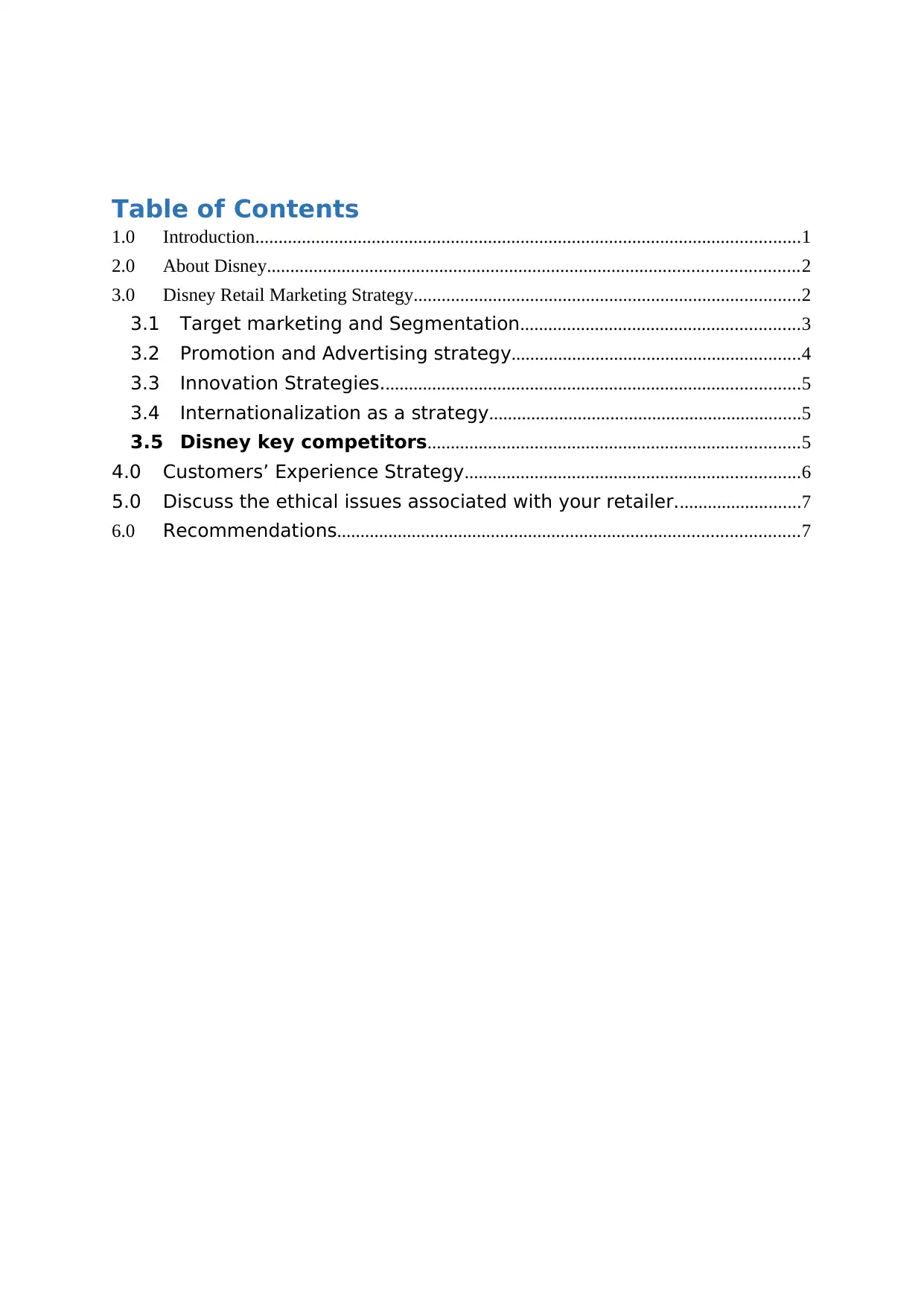
Table of Contents
1.0 Introduction.....................................................................................................................1
2.0 About Disney..................................................................................................................2
3.0 Disney Retail Marketing Strategy...................................................................................2
3.1 Target marketing and Segmentation............................................................3
3.2 Promotion and Advertising strategy..............................................................4
3.3 Innovation Strategies..........................................................................................5
3.4 Internationalization as a strategy...................................................................5
3.5 Disney key competitors................................................................................5
4.0 Customers’ Experience Strategy........................................................................6
5.0 Discuss the ethical issues associated with your retailer...........................7
6.0 Recommendations...................................................................................................7
1.0 Introduction.....................................................................................................................1
2.0 About Disney..................................................................................................................2
3.0 Disney Retail Marketing Strategy...................................................................................2
3.1 Target marketing and Segmentation............................................................3
3.2 Promotion and Advertising strategy..............................................................4
3.3 Innovation Strategies..........................................................................................5
3.4 Internationalization as a strategy...................................................................5
3.5 Disney key competitors................................................................................5
4.0 Customers’ Experience Strategy........................................................................6
5.0 Discuss the ethical issues associated with your retailer...........................7
6.0 Recommendations...................................................................................................7
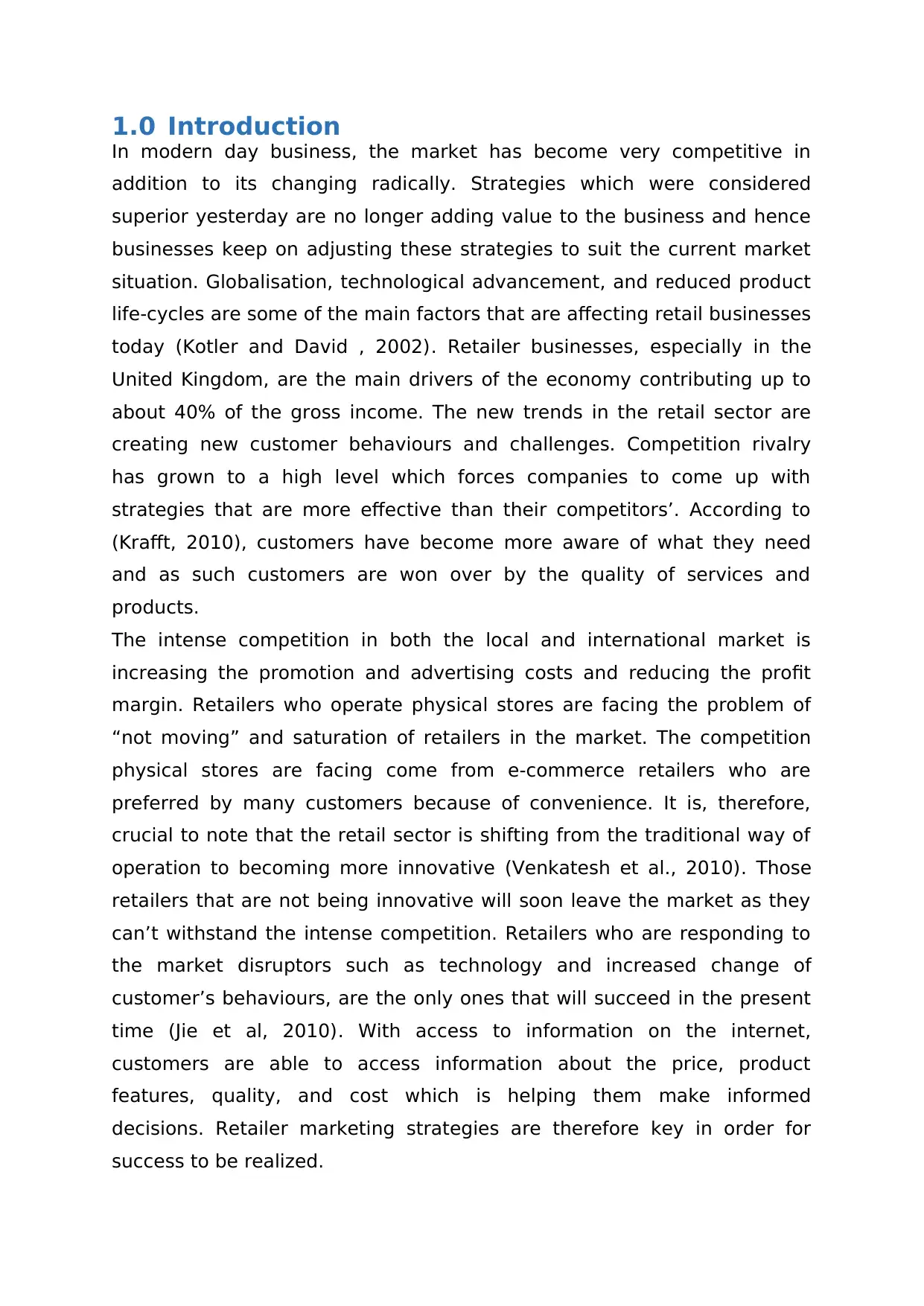
1.0 Introduction
In modern day business, the market has become very competitive in
addition to its changing radically. Strategies which were considered
superior yesterday are no longer adding value to the business and hence
businesses keep on adjusting these strategies to suit the current market
situation. Globalisation, technological advancement, and reduced product
life-cycles are some of the main factors that are affecting retail businesses
today (Kotler and David , 2002). Retailer businesses, especially in the
United Kingdom, are the main drivers of the economy contributing up to
about 40% of the gross income. The new trends in the retail sector are
creating new customer behaviours and challenges. Competition rivalry
has grown to a high level which forces companies to come up with
strategies that are more effective than their competitors’. According to
(Krafft, 2010), customers have become more aware of what they need
and as such customers are won over by the quality of services and
products.
The intense competition in both the local and international market is
increasing the promotion and advertising costs and reducing the profit
margin. Retailers who operate physical stores are facing the problem of
“not moving” and saturation of retailers in the market. The competition
physical stores are facing come from e-commerce retailers who are
preferred by many customers because of convenience. It is, therefore,
crucial to note that the retail sector is shifting from the traditional way of
operation to becoming more innovative (Venkatesh et al., 2010). Those
retailers that are not being innovative will soon leave the market as they
can’t withstand the intense competition. Retailers who are responding to
the market disruptors such as technology and increased change of
customer’s behaviours, are the only ones that will succeed in the present
time (Jie et al, 2010). With access to information on the internet,
customers are able to access information about the price, product
features, quality, and cost which is helping them make informed
decisions. Retailer marketing strategies are therefore key in order for
success to be realized.
In modern day business, the market has become very competitive in
addition to its changing radically. Strategies which were considered
superior yesterday are no longer adding value to the business and hence
businesses keep on adjusting these strategies to suit the current market
situation. Globalisation, technological advancement, and reduced product
life-cycles are some of the main factors that are affecting retail businesses
today (Kotler and David , 2002). Retailer businesses, especially in the
United Kingdom, are the main drivers of the economy contributing up to
about 40% of the gross income. The new trends in the retail sector are
creating new customer behaviours and challenges. Competition rivalry
has grown to a high level which forces companies to come up with
strategies that are more effective than their competitors’. According to
(Krafft, 2010), customers have become more aware of what they need
and as such customers are won over by the quality of services and
products.
The intense competition in both the local and international market is
increasing the promotion and advertising costs and reducing the profit
margin. Retailers who operate physical stores are facing the problem of
“not moving” and saturation of retailers in the market. The competition
physical stores are facing come from e-commerce retailers who are
preferred by many customers because of convenience. It is, therefore,
crucial to note that the retail sector is shifting from the traditional way of
operation to becoming more innovative (Venkatesh et al., 2010). Those
retailers that are not being innovative will soon leave the market as they
can’t withstand the intense competition. Retailers who are responding to
the market disruptors such as technology and increased change of
customer’s behaviours, are the only ones that will succeed in the present
time (Jie et al, 2010). With access to information on the internet,
customers are able to access information about the price, product
features, quality, and cost which is helping them make informed
decisions. Retailer marketing strategies are therefore key in order for
success to be realized.
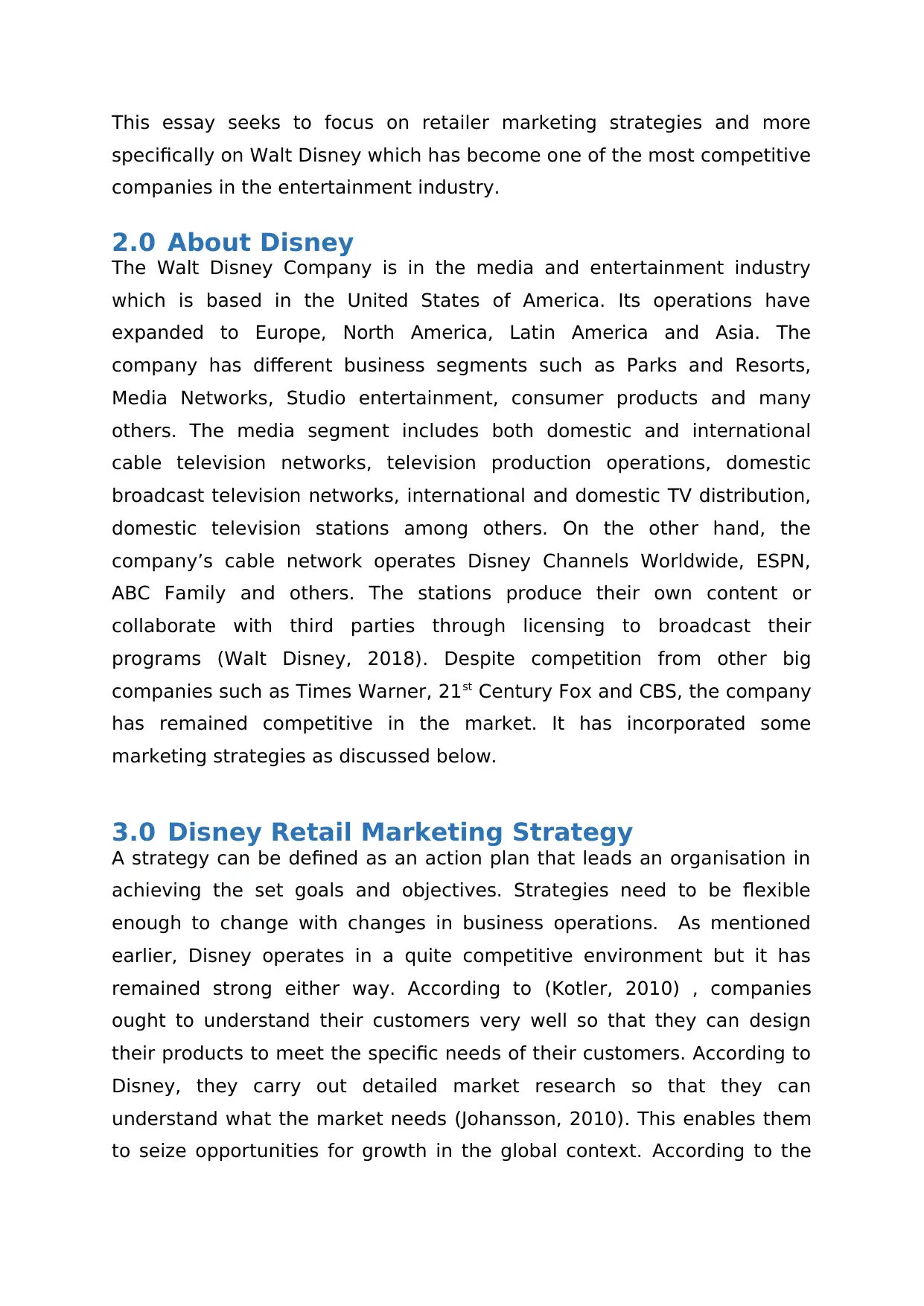
This essay seeks to focus on retailer marketing strategies and more
specifically on Walt Disney which has become one of the most competitive
companies in the entertainment industry.
2.0 About Disney
The Walt Disney Company is in the media and entertainment industry
which is based in the United States of America. Its operations have
expanded to Europe, North America, Latin America and Asia. The
company has different business segments such as Parks and Resorts,
Media Networks, Studio entertainment, consumer products and many
others. The media segment includes both domestic and international
cable television networks, television production operations, domestic
broadcast television networks, international and domestic TV distribution,
domestic television stations among others. On the other hand, the
company’s cable network operates Disney Channels Worldwide, ESPN,
ABC Family and others. The stations produce their own content or
collaborate with third parties through licensing to broadcast their
programs (Walt Disney, 2018). Despite competition from other big
companies such as Times Warner, 21st Century Fox and CBS, the company
has remained competitive in the market. It has incorporated some
marketing strategies as discussed below.
3.0 Disney Retail Marketing Strategy
A strategy can be defined as an action plan that leads an organisation in
achieving the set goals and objectives. Strategies need to be flexible
enough to change with changes in business operations. As mentioned
earlier, Disney operates in a quite competitive environment but it has
remained strong either way. According to (Kotler, 2010) , companies
ought to understand their customers very well so that they can design
their products to meet the specific needs of their customers. According to
Disney, they carry out detailed market research so that they can
understand what the market needs (Johansson, 2010). This enables them
to seize opportunities for growth in the global context. According to the
specifically on Walt Disney which has become one of the most competitive
companies in the entertainment industry.
2.0 About Disney
The Walt Disney Company is in the media and entertainment industry
which is based in the United States of America. Its operations have
expanded to Europe, North America, Latin America and Asia. The
company has different business segments such as Parks and Resorts,
Media Networks, Studio entertainment, consumer products and many
others. The media segment includes both domestic and international
cable television networks, television production operations, domestic
broadcast television networks, international and domestic TV distribution,
domestic television stations among others. On the other hand, the
company’s cable network operates Disney Channels Worldwide, ESPN,
ABC Family and others. The stations produce their own content or
collaborate with third parties through licensing to broadcast their
programs (Walt Disney, 2018). Despite competition from other big
companies such as Times Warner, 21st Century Fox and CBS, the company
has remained competitive in the market. It has incorporated some
marketing strategies as discussed below.
3.0 Disney Retail Marketing Strategy
A strategy can be defined as an action plan that leads an organisation in
achieving the set goals and objectives. Strategies need to be flexible
enough to change with changes in business operations. As mentioned
earlier, Disney operates in a quite competitive environment but it has
remained strong either way. According to (Kotler, 2010) , companies
ought to understand their customers very well so that they can design
their products to meet the specific needs of their customers. According to
Disney, they carry out detailed market research so that they can
understand what the market needs (Johansson, 2010). This enables them
to seize opportunities for growth in the global context. According to the
Secure Best Marks with AI Grader
Need help grading? Try our AI Grader for instant feedback on your assignments.
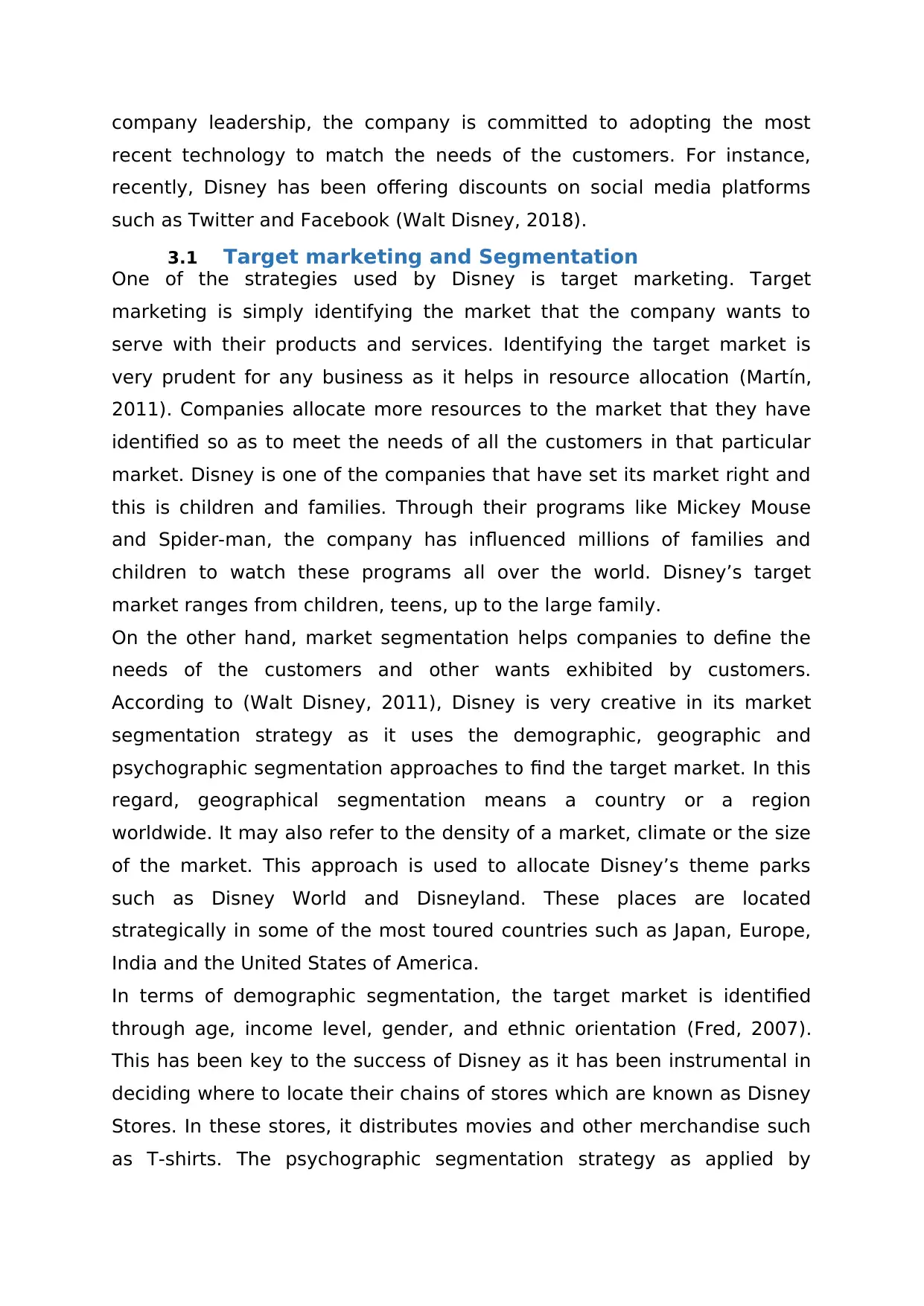
company leadership, the company is committed to adopting the most
recent technology to match the needs of the customers. For instance,
recently, Disney has been offering discounts on social media platforms
such as Twitter and Facebook (Walt Disney, 2018).
3.1 Target marketing and Segmentation
One of the strategies used by Disney is target marketing. Target
marketing is simply identifying the market that the company wants to
serve with their products and services. Identifying the target market is
very prudent for any business as it helps in resource allocation (Martín,
2011). Companies allocate more resources to the market that they have
identified so as to meet the needs of all the customers in that particular
market. Disney is one of the companies that have set its market right and
this is children and families. Through their programs like Mickey Mouse
and Spider-man, the company has influenced millions of families and
children to watch these programs all over the world. Disney’s target
market ranges from children, teens, up to the large family.
On the other hand, market segmentation helps companies to define the
needs of the customers and other wants exhibited by customers.
According to (Walt Disney, 2011), Disney is very creative in its market
segmentation strategy as it uses the demographic, geographic and
psychographic segmentation approaches to find the target market. In this
regard, geographical segmentation means a country or a region
worldwide. It may also refer to the density of a market, climate or the size
of the market. This approach is used to allocate Disney’s theme parks
such as Disney World and Disneyland. These places are located
strategically in some of the most toured countries such as Japan, Europe,
India and the United States of America.
In terms of demographic segmentation, the target market is identified
through age, income level, gender, and ethnic orientation (Fred, 2007).
This has been key to the success of Disney as it has been instrumental in
deciding where to locate their chains of stores which are known as Disney
Stores. In these stores, it distributes movies and other merchandise such
as T-shirts. The psychographic segmentation strategy as applied by
recent technology to match the needs of the customers. For instance,
recently, Disney has been offering discounts on social media platforms
such as Twitter and Facebook (Walt Disney, 2018).
3.1 Target marketing and Segmentation
One of the strategies used by Disney is target marketing. Target
marketing is simply identifying the market that the company wants to
serve with their products and services. Identifying the target market is
very prudent for any business as it helps in resource allocation (Martín,
2011). Companies allocate more resources to the market that they have
identified so as to meet the needs of all the customers in that particular
market. Disney is one of the companies that have set its market right and
this is children and families. Through their programs like Mickey Mouse
and Spider-man, the company has influenced millions of families and
children to watch these programs all over the world. Disney’s target
market ranges from children, teens, up to the large family.
On the other hand, market segmentation helps companies to define the
needs of the customers and other wants exhibited by customers.
According to (Walt Disney, 2011), Disney is very creative in its market
segmentation strategy as it uses the demographic, geographic and
psychographic segmentation approaches to find the target market. In this
regard, geographical segmentation means a country or a region
worldwide. It may also refer to the density of a market, climate or the size
of the market. This approach is used to allocate Disney’s theme parks
such as Disney World and Disneyland. These places are located
strategically in some of the most toured countries such as Japan, Europe,
India and the United States of America.
In terms of demographic segmentation, the target market is identified
through age, income level, gender, and ethnic orientation (Fred, 2007).
This has been key to the success of Disney as it has been instrumental in
deciding where to locate their chains of stores which are known as Disney
Stores. In these stores, it distributes movies and other merchandise such
as T-shirts. The psychographic segmentation strategy as applied by
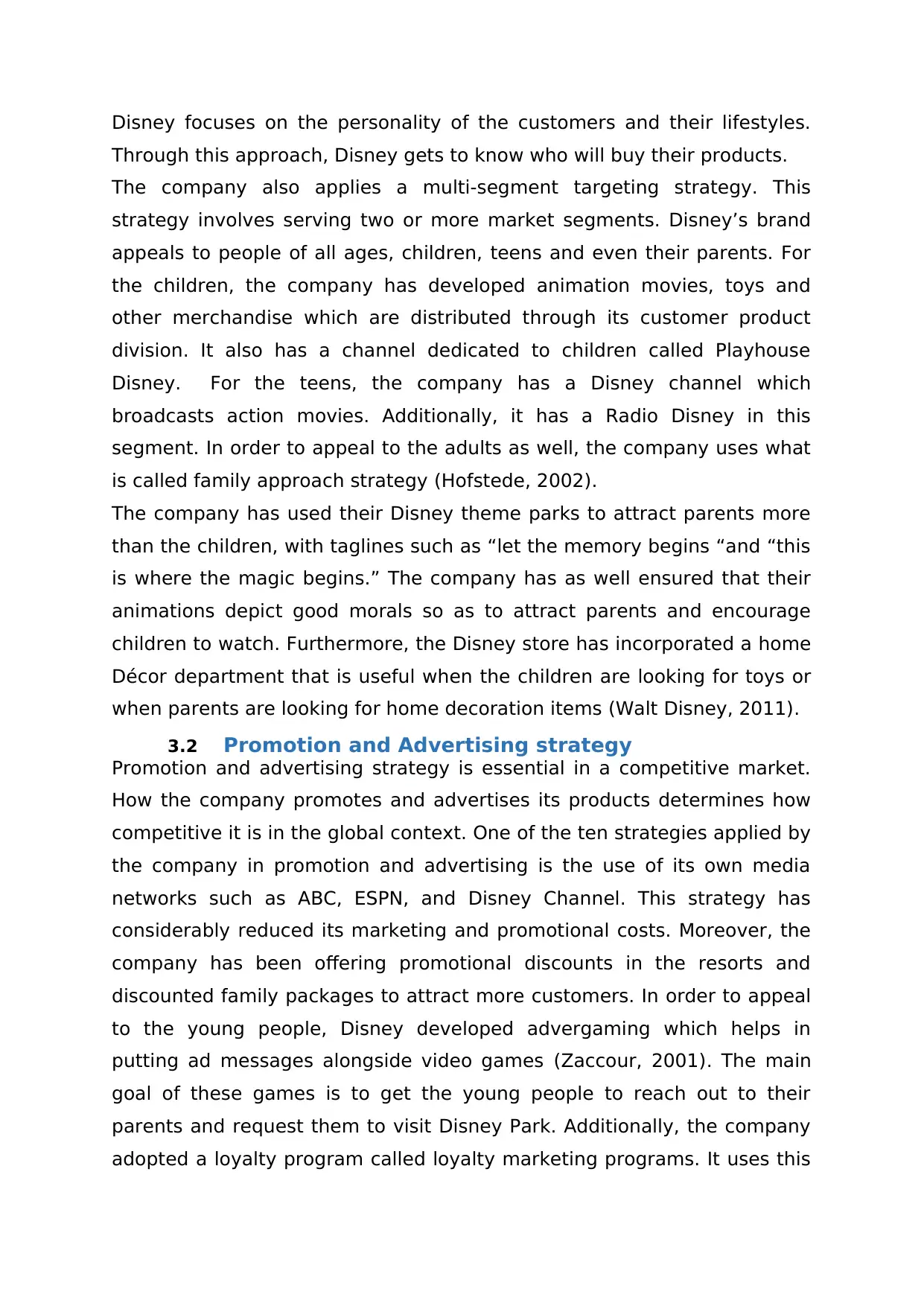
Disney focuses on the personality of the customers and their lifestyles.
Through this approach, Disney gets to know who will buy their products.
The company also applies a multi-segment targeting strategy. This
strategy involves serving two or more market segments. Disney’s brand
appeals to people of all ages, children, teens and even their parents. For
the children, the company has developed animation movies, toys and
other merchandise which are distributed through its customer product
division. It also has a channel dedicated to children called Playhouse
Disney. For the teens, the company has a Disney channel which
broadcasts action movies. Additionally, it has a Radio Disney in this
segment. In order to appeal to the adults as well, the company uses what
is called family approach strategy (Hofstede, 2002).
The company has used their Disney theme parks to attract parents more
than the children, with taglines such as “let the memory begins “and “this
is where the magic begins.” The company has as well ensured that their
animations depict good morals so as to attract parents and encourage
children to watch. Furthermore, the Disney store has incorporated a home
Décor department that is useful when the children are looking for toys or
when parents are looking for home decoration items (Walt Disney, 2011).
3.2 Promotion and Advertising strategy
Promotion and advertising strategy is essential in a competitive market.
How the company promotes and advertises its products determines how
competitive it is in the global context. One of the ten strategies applied by
the company in promotion and advertising is the use of its own media
networks such as ABC, ESPN, and Disney Channel. This strategy has
considerably reduced its marketing and promotional costs. Moreover, the
company has been offering promotional discounts in the resorts and
discounted family packages to attract more customers. In order to appeal
to the young people, Disney developed advergaming which helps in
putting ad messages alongside video games (Zaccour, 2001). The main
goal of these games is to get the young people to reach out to their
parents and request them to visit Disney Park. Additionally, the company
adopted a loyalty program called loyalty marketing programs. It uses this
Through this approach, Disney gets to know who will buy their products.
The company also applies a multi-segment targeting strategy. This
strategy involves serving two or more market segments. Disney’s brand
appeals to people of all ages, children, teens and even their parents. For
the children, the company has developed animation movies, toys and
other merchandise which are distributed through its customer product
division. It also has a channel dedicated to children called Playhouse
Disney. For the teens, the company has a Disney channel which
broadcasts action movies. Additionally, it has a Radio Disney in this
segment. In order to appeal to the adults as well, the company uses what
is called family approach strategy (Hofstede, 2002).
The company has used their Disney theme parks to attract parents more
than the children, with taglines such as “let the memory begins “and “this
is where the magic begins.” The company has as well ensured that their
animations depict good morals so as to attract parents and encourage
children to watch. Furthermore, the Disney store has incorporated a home
Décor department that is useful when the children are looking for toys or
when parents are looking for home decoration items (Walt Disney, 2011).
3.2 Promotion and Advertising strategy
Promotion and advertising strategy is essential in a competitive market.
How the company promotes and advertises its products determines how
competitive it is in the global context. One of the ten strategies applied by
the company in promotion and advertising is the use of its own media
networks such as ABC, ESPN, and Disney Channel. This strategy has
considerably reduced its marketing and promotional costs. Moreover, the
company has been offering promotional discounts in the resorts and
discounted family packages to attract more customers. In order to appeal
to the young people, Disney developed advergaming which helps in
putting ad messages alongside video games (Zaccour, 2001). The main
goal of these games is to get the young people to reach out to their
parents and request them to visit Disney Park. Additionally, the company
adopted a loyalty program called loyalty marketing programs. It uses this

strategy to reach its loyal customers by sending the catalogs with new
products, rebates, and coupons. In order to reach out to the new
millennial generation, the company has innovated online sales promotion.
It creates promotional messages and tags them on the Disney stores
website. For instance, you may find messages such as; “Free shipping on
your order of 80 dollars and above. (Walt Disney, 2011, p. 1)” This
approach has been so effective and convenient to both the store and the
company at large. According to (Jan-Benedict et al, 2005), customers in
the current market are looking for convenience and every firm that is
offering this has become one of the most competitive firms and the most
successful firms in the entertainment industry.
3.3 Innovation Strategies.
Innovation is one of the major differentiators in the market and a source
of competition in the present day. In many organisations, the traditional
recruitment process based on qualification and the level of education has
changed. Many companies are looking for employees who are creative
enough to steer the company ahead of the competition and stay ahead of
other firms. With the high level of technological advancement, Disney has
been innovative enough to come up with strategies that appeal to children
through storytelling by using different kinds of technologies (Robert et al,
2012). It has as well come up with innovatively designed loyal marketing
tools called co-branded credit cards in collaboration with Visa. The Disney
reward Visa Credit card is one of the innovative means of promotion
convenience as well luring customers to buy more products and services.
They have set the card in such a way that for every purchase above 50
dollars the client saves 10 % on the select goods (Walt Disney, 2011).
3.4 Internationalization as a strategy
According to (BusinessEssays.net, 2010), Disney perceived business
opportunities in the global market as not all people could come to the USA
at the Disney World of Disney land. Disney came up with a global strategy
to create theme parks in different parts of the world to reach out to the
growing market and adapt to the cultures of such places. Out of this
products, rebates, and coupons. In order to reach out to the new
millennial generation, the company has innovated online sales promotion.
It creates promotional messages and tags them on the Disney stores
website. For instance, you may find messages such as; “Free shipping on
your order of 80 dollars and above. (Walt Disney, 2011, p. 1)” This
approach has been so effective and convenient to both the store and the
company at large. According to (Jan-Benedict et al, 2005), customers in
the current market are looking for convenience and every firm that is
offering this has become one of the most competitive firms and the most
successful firms in the entertainment industry.
3.3 Innovation Strategies.
Innovation is one of the major differentiators in the market and a source
of competition in the present day. In many organisations, the traditional
recruitment process based on qualification and the level of education has
changed. Many companies are looking for employees who are creative
enough to steer the company ahead of the competition and stay ahead of
other firms. With the high level of technological advancement, Disney has
been innovative enough to come up with strategies that appeal to children
through storytelling by using different kinds of technologies (Robert et al,
2012). It has as well come up with innovatively designed loyal marketing
tools called co-branded credit cards in collaboration with Visa. The Disney
reward Visa Credit card is one of the innovative means of promotion
convenience as well luring customers to buy more products and services.
They have set the card in such a way that for every purchase above 50
dollars the client saves 10 % on the select goods (Walt Disney, 2011).
3.4 Internationalization as a strategy
According to (BusinessEssays.net, 2010), Disney perceived business
opportunities in the global market as not all people could come to the USA
at the Disney World of Disney land. Disney came up with a global strategy
to create theme parks in different parts of the world to reach out to the
growing market and adapt to the cultures of such places. Out of this
Paraphrase This Document
Need a fresh take? Get an instant paraphrase of this document with our AI Paraphraser
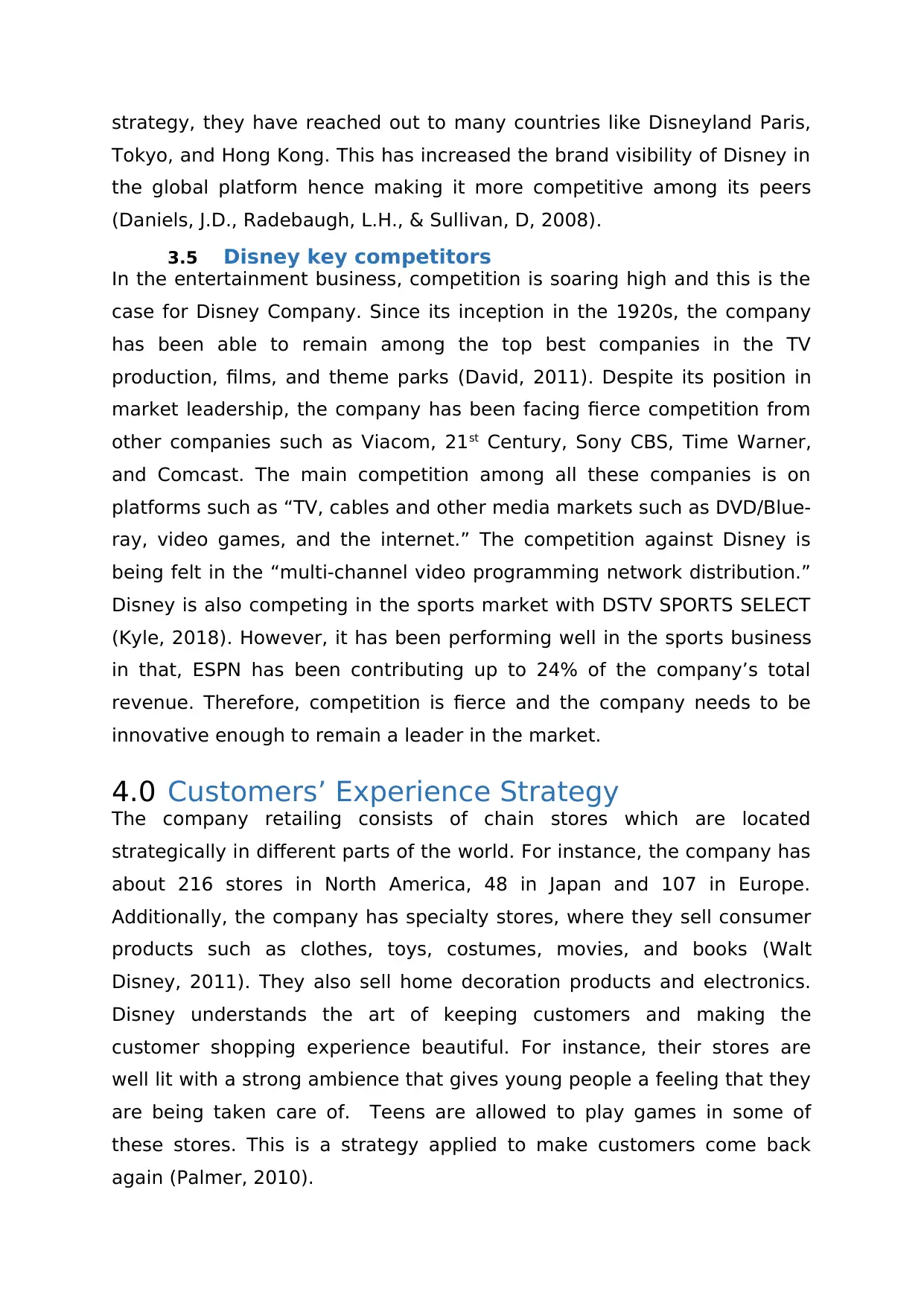
strategy, they have reached out to many countries like Disneyland Paris,
Tokyo, and Hong Kong. This has increased the brand visibility of Disney in
the global platform hence making it more competitive among its peers
(Daniels, J.D., Radebaugh, L.H., & Sullivan, D, 2008).
3.5 Disney key competitors
In the entertainment business, competition is soaring high and this is the
case for Disney Company. Since its inception in the 1920s, the company
has been able to remain among the top best companies in the TV
production, films, and theme parks (David, 2011). Despite its position in
market leadership, the company has been facing fierce competition from
other companies such as Viacom, 21st Century, Sony CBS, Time Warner,
and Comcast. The main competition among all these companies is on
platforms such as “TV, cables and other media markets such as DVD/Blue-
ray, video games, and the internet.” The competition against Disney is
being felt in the “multi-channel video programming network distribution.”
Disney is also competing in the sports market with DSTV SPORTS SELECT
(Kyle, 2018). However, it has been performing well in the sports business
in that, ESPN has been contributing up to 24% of the company’s total
revenue. Therefore, competition is fierce and the company needs to be
innovative enough to remain a leader in the market.
4.0 Customers’ Experience Strategy
The company retailing consists of chain stores which are located
strategically in different parts of the world. For instance, the company has
about 216 stores in North America, 48 in Japan and 107 in Europe.
Additionally, the company has specialty stores, where they sell consumer
products such as clothes, toys, costumes, movies, and books (Walt
Disney, 2011). They also sell home decoration products and electronics.
Disney understands the art of keeping customers and making the
customer shopping experience beautiful. For instance, their stores are
well lit with a strong ambience that gives young people a feeling that they
are being taken care of. Teens are allowed to play games in some of
these stores. This is a strategy applied to make customers come back
again (Palmer, 2010).
Tokyo, and Hong Kong. This has increased the brand visibility of Disney in
the global platform hence making it more competitive among its peers
(Daniels, J.D., Radebaugh, L.H., & Sullivan, D, 2008).
3.5 Disney key competitors
In the entertainment business, competition is soaring high and this is the
case for Disney Company. Since its inception in the 1920s, the company
has been able to remain among the top best companies in the TV
production, films, and theme parks (David, 2011). Despite its position in
market leadership, the company has been facing fierce competition from
other companies such as Viacom, 21st Century, Sony CBS, Time Warner,
and Comcast. The main competition among all these companies is on
platforms such as “TV, cables and other media markets such as DVD/Blue-
ray, video games, and the internet.” The competition against Disney is
being felt in the “multi-channel video programming network distribution.”
Disney is also competing in the sports market with DSTV SPORTS SELECT
(Kyle, 2018). However, it has been performing well in the sports business
in that, ESPN has been contributing up to 24% of the company’s total
revenue. Therefore, competition is fierce and the company needs to be
innovative enough to remain a leader in the market.
4.0 Customers’ Experience Strategy
The company retailing consists of chain stores which are located
strategically in different parts of the world. For instance, the company has
about 216 stores in North America, 48 in Japan and 107 in Europe.
Additionally, the company has specialty stores, where they sell consumer
products such as clothes, toys, costumes, movies, and books (Walt
Disney, 2011). They also sell home decoration products and electronics.
Disney understands the art of keeping customers and making the
customer shopping experience beautiful. For instance, their stores are
well lit with a strong ambience that gives young people a feeling that they
are being taken care of. Teens are allowed to play games in some of
these stores. This is a strategy applied to make customers come back
again (Palmer, 2010).
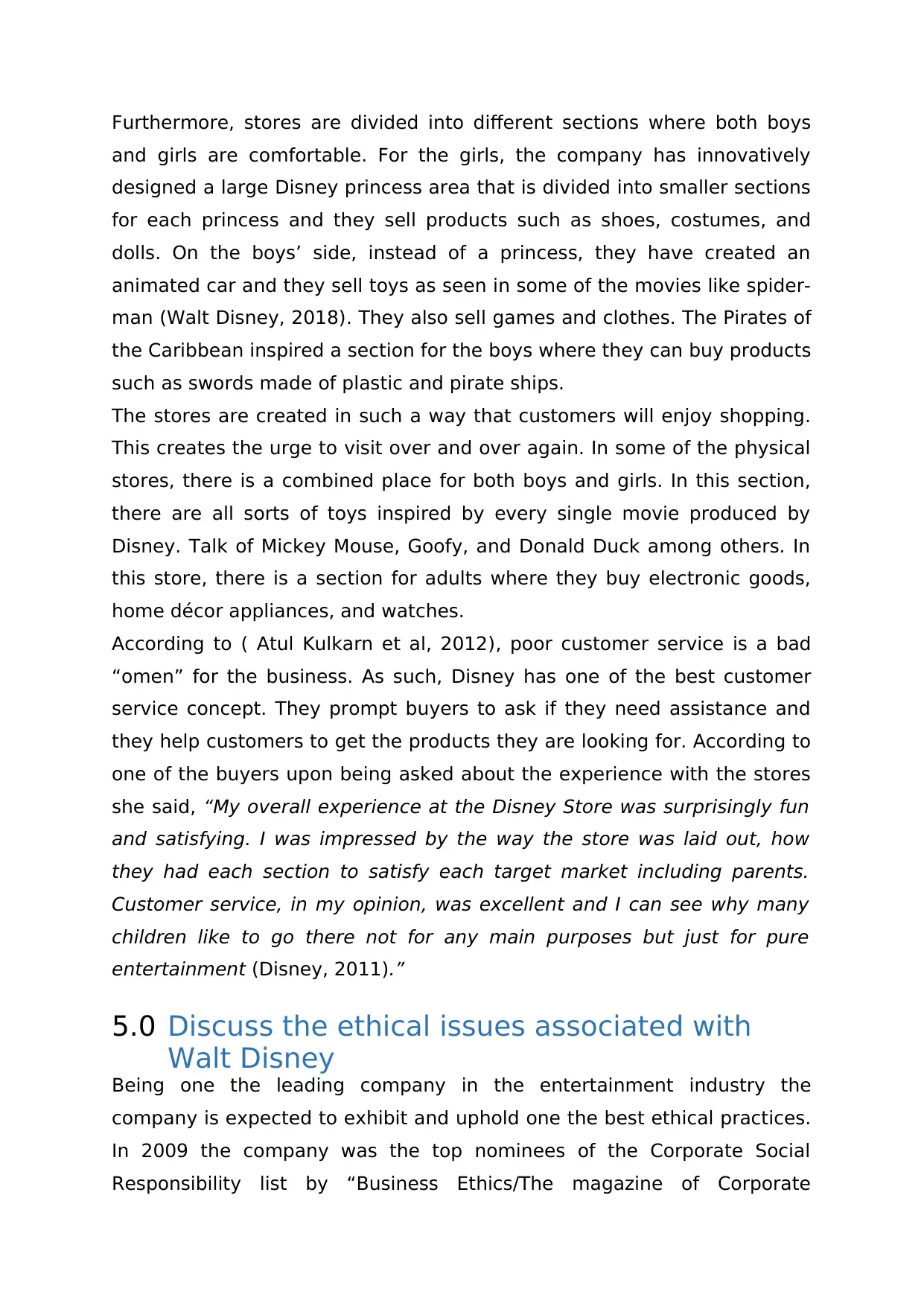
Furthermore, stores are divided into different sections where both boys
and girls are comfortable. For the girls, the company has innovatively
designed a large Disney princess area that is divided into smaller sections
for each princess and they sell products such as shoes, costumes, and
dolls. On the boys’ side, instead of a princess, they have created an
animated car and they sell toys as seen in some of the movies like spider-
man (Walt Disney, 2018). They also sell games and clothes. The Pirates of
the Caribbean inspired a section for the boys where they can buy products
such as swords made of plastic and pirate ships.
The stores are created in such a way that customers will enjoy shopping.
This creates the urge to visit over and over again. In some of the physical
stores, there is a combined place for both boys and girls. In this section,
there are all sorts of toys inspired by every single movie produced by
Disney. Talk of Mickey Mouse, Goofy, and Donald Duck among others. In
this store, there is a section for adults where they buy electronic goods,
home décor appliances, and watches.
According to ( Atul Kulkarn et al, 2012), poor customer service is a bad
“omen” for the business. As such, Disney has one of the best customer
service concept. They prompt buyers to ask if they need assistance and
they help customers to get the products they are looking for. According to
one of the buyers upon being asked about the experience with the stores
she said, “My overall experience at the Disney Store was surprisingly fun
and satisfying. I was impressed by the way the store was laid out, how
they had each section to satisfy each target market including parents.
Customer service, in my opinion, was excellent and I can see why many
children like to go there not for any main purposes but just for pure
entertainment (Disney, 2011).”
5.0 Discuss the ethical issues associated with
Walt Disney
Being one the leading company in the entertainment industry the
company is expected to exhibit and uphold one the best ethical practices.
In 2009 the company was the top nominees of the Corporate Social
Responsibility list by “Business Ethics/The magazine of Corporate
and girls are comfortable. For the girls, the company has innovatively
designed a large Disney princess area that is divided into smaller sections
for each princess and they sell products such as shoes, costumes, and
dolls. On the boys’ side, instead of a princess, they have created an
animated car and they sell toys as seen in some of the movies like spider-
man (Walt Disney, 2018). They also sell games and clothes. The Pirates of
the Caribbean inspired a section for the boys where they can buy products
such as swords made of plastic and pirate ships.
The stores are created in such a way that customers will enjoy shopping.
This creates the urge to visit over and over again. In some of the physical
stores, there is a combined place for both boys and girls. In this section,
there are all sorts of toys inspired by every single movie produced by
Disney. Talk of Mickey Mouse, Goofy, and Donald Duck among others. In
this store, there is a section for adults where they buy electronic goods,
home décor appliances, and watches.
According to ( Atul Kulkarn et al, 2012), poor customer service is a bad
“omen” for the business. As such, Disney has one of the best customer
service concept. They prompt buyers to ask if they need assistance and
they help customers to get the products they are looking for. According to
one of the buyers upon being asked about the experience with the stores
she said, “My overall experience at the Disney Store was surprisingly fun
and satisfying. I was impressed by the way the store was laid out, how
they had each section to satisfy each target market including parents.
Customer service, in my opinion, was excellent and I can see why many
children like to go there not for any main purposes but just for pure
entertainment (Disney, 2011).”
5.0 Discuss the ethical issues associated with
Walt Disney
Being one the leading company in the entertainment industry the
company is expected to exhibit and uphold one the best ethical practices.
In 2009 the company was the top nominees of the Corporate Social
Responsibility list by “Business Ethics/The magazine of Corporate

Responsibility (Disney, 2011).” The company lives by the code that
conducting business in an ethical manner shows respect for human rights.
However, the company has been caught in the mix of some ethical issues.
For instance, the company was accused of laying off some technicians in
2015 without following the due process. The company laid off over 250
technicians on the data section during the restructuring of the company.
However, after investigation, it was found that the company terminated
their contracts so as to increase their profit margin in the future.
Additionally, during their construction of Shanghai Disney land, the
company was accused of causing the death of over 90% of fish in
Changsha Bay. This was a result of the pollution of the bay even after an
assurance that they observe the highest standards of environment
cleaning by ensuring 0-pollution (Bruner, 2017).
6.0 Recommendations
According to (Daniels, J.D., Radebaugh, L.H., & Sullivan, D, 2008), Disney
has adopted a generic strategy which has given them a competitive
advantage in the market. To remain number one in the industry, the
company needs to revamp its retail strategies. Due to the increased level
of digital growth, many organisations have gone online with a very
elaborate e-commerce strategy. However, Disney has not wholly
conceptualized the whole aspect of e-commerce. According to (Daniels,
J.D., Radebaugh, L.H., & Sullivan, D, 2008), customers are looking for
efficiency and convenience, and as such, Disney should position itself
through e-commerce in order to reach out to many customers globally by
delivering products at customers’ convenience. Secondly, Disney needs to
create a seamless kind of transition between their stores, parks and online
stores as it seeks to improve on customers’ experience. Disney’s desire is
to tap into the round-the-clock economy, and if their customer service on
the physical stores is matched with that of online stores, then the
business will improve its performance. Thirdly, there are a lot of
opportunities that need to be explored globally, for instance, according to
(Zyl, 2011), Africa is at the verge of becoming one the largest economies
conducting business in an ethical manner shows respect for human rights.
However, the company has been caught in the mix of some ethical issues.
For instance, the company was accused of laying off some technicians in
2015 without following the due process. The company laid off over 250
technicians on the data section during the restructuring of the company.
However, after investigation, it was found that the company terminated
their contracts so as to increase their profit margin in the future.
Additionally, during their construction of Shanghai Disney land, the
company was accused of causing the death of over 90% of fish in
Changsha Bay. This was a result of the pollution of the bay even after an
assurance that they observe the highest standards of environment
cleaning by ensuring 0-pollution (Bruner, 2017).
6.0 Recommendations
According to (Daniels, J.D., Radebaugh, L.H., & Sullivan, D, 2008), Disney
has adopted a generic strategy which has given them a competitive
advantage in the market. To remain number one in the industry, the
company needs to revamp its retail strategies. Due to the increased level
of digital growth, many organisations have gone online with a very
elaborate e-commerce strategy. However, Disney has not wholly
conceptualized the whole aspect of e-commerce. According to (Daniels,
J.D., Radebaugh, L.H., & Sullivan, D, 2008), customers are looking for
efficiency and convenience, and as such, Disney should position itself
through e-commerce in order to reach out to many customers globally by
delivering products at customers’ convenience. Secondly, Disney needs to
create a seamless kind of transition between their stores, parks and online
stores as it seeks to improve on customers’ experience. Disney’s desire is
to tap into the round-the-clock economy, and if their customer service on
the physical stores is matched with that of online stores, then the
business will improve its performance. Thirdly, there are a lot of
opportunities that need to be explored globally, for instance, according to
(Zyl, 2011), Africa is at the verge of becoming one the largest economies
Secure Best Marks with AI Grader
Need help grading? Try our AI Grader for instant feedback on your assignments.
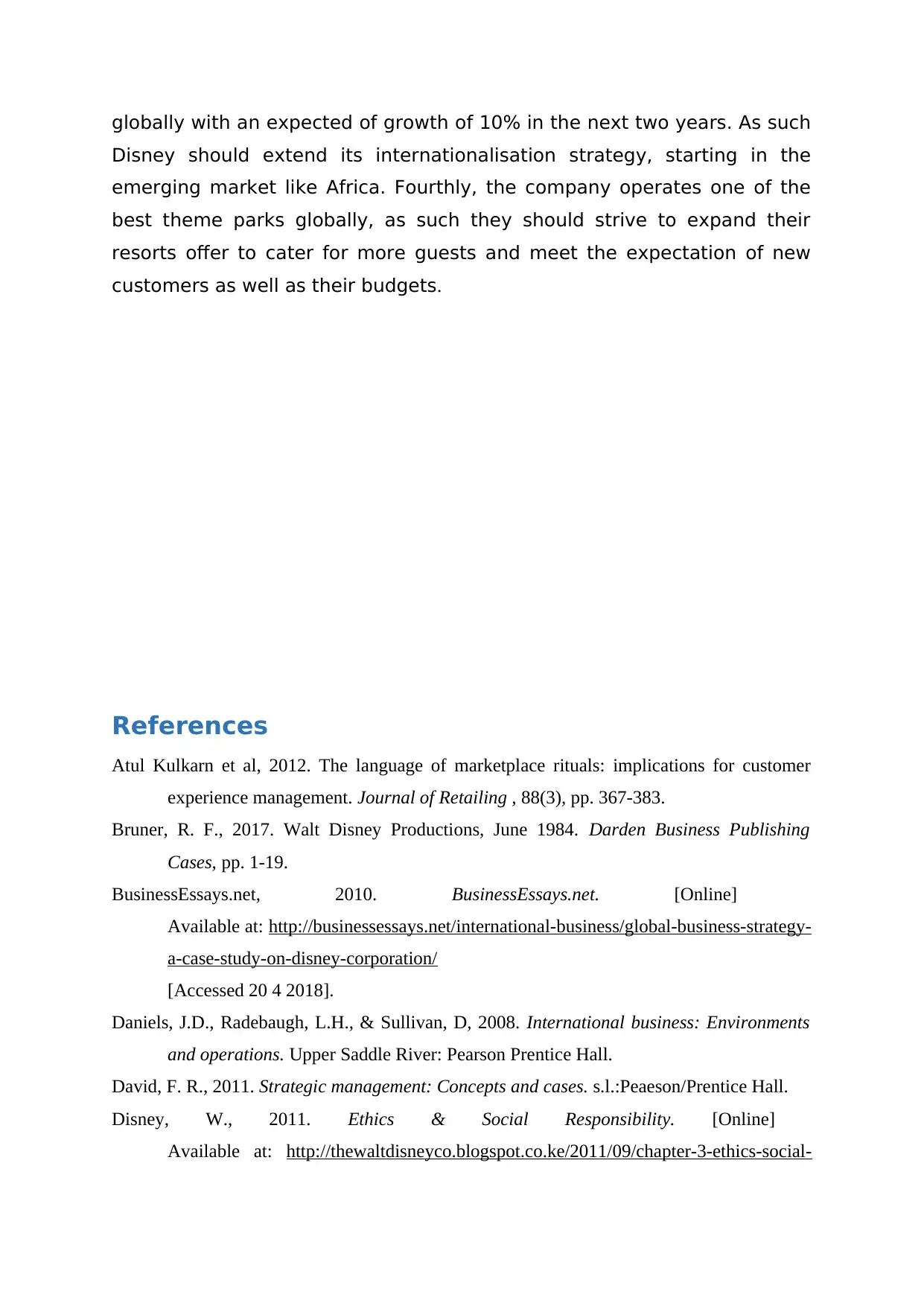
globally with an expected of growth of 10% in the next two years. As such
Disney should extend its internationalisation strategy, starting in the
emerging market like Africa. Fourthly, the company operates one of the
best theme parks globally, as such they should strive to expand their
resorts offer to cater for more guests and meet the expectation of new
customers as well as their budgets.
References
Atul Kulkarn et al, 2012. The language of marketplace rituals: implications for customer
experience management. Journal of Retailing , 88(3), pp. 367-383.
Bruner, R. F., 2017. Walt Disney Productions, June 1984. Darden Business Publishing
Cases, pp. 1-19.
BusinessEssays.net, 2010. BusinessEssays.net. [Online]
Available at: http://businessessays.net/international-business/global-business-strategy-
a-case-study-on-disney-corporation/
[Accessed 20 4 2018].
Daniels, J.D., Radebaugh, L.H., & Sullivan, D, 2008. International business: Environments
and operations. Upper Saddle River: Pearson Prentice Hall.
David, F. R., 2011. Strategic management: Concepts and cases. s.l.:Peaeson/Prentice Hall.
Disney, W., 2011. Ethics & Social Responsibility. [Online]
Available at: http://thewaltdisneyco.blogspot.co.ke/2011/09/chapter-3-ethics-social-
Disney should extend its internationalisation strategy, starting in the
emerging market like Africa. Fourthly, the company operates one of the
best theme parks globally, as such they should strive to expand their
resorts offer to cater for more guests and meet the expectation of new
customers as well as their budgets.
References
Atul Kulkarn et al, 2012. The language of marketplace rituals: implications for customer
experience management. Journal of Retailing , 88(3), pp. 367-383.
Bruner, R. F., 2017. Walt Disney Productions, June 1984. Darden Business Publishing
Cases, pp. 1-19.
BusinessEssays.net, 2010. BusinessEssays.net. [Online]
Available at: http://businessessays.net/international-business/global-business-strategy-
a-case-study-on-disney-corporation/
[Accessed 20 4 2018].
Daniels, J.D., Radebaugh, L.H., & Sullivan, D, 2008. International business: Environments
and operations. Upper Saddle River: Pearson Prentice Hall.
David, F. R., 2011. Strategic management: Concepts and cases. s.l.:Peaeson/Prentice Hall.
Disney, W., 2011. Ethics & Social Responsibility. [Online]
Available at: http://thewaltdisneyco.blogspot.co.ke/2011/09/chapter-3-ethics-social-

responsibility.html
[Accessed 20 4 2018].
Disney, W., 2011. Retailing. [Online]
Available at: http://thewaltdisneyco.blogspot.co.ke/2011/10/chapter-15-retailing.html
[Accessed 20 4 2018].
Fred, W., 2007. Globalisation of marketing communication?. Journal of Economic
Psychology , pp. 259-270.
Hofstede, F. T., 2002. International market segmentation: issues and perspectives.
International Journal of Research in Marketing, pp. 185-213.
Jan-Benedict et al, 2005. Competitive reactions to advertising and promotion attacks.
Marketing science, pp. 35-54.
Jie et al, 2010. Crafting integrated multichannel retailing strategies. Journal of Interactive
Marketing, 24(2), pp. 168-180..
Johansson, J. K., 2010. Global Marketing Strategy. Wiley International Encyclopedia of
Marketing.
Kotler and David , 2002. Country as brand, product, and beyond: A place marketing and
brand management perspective. Journal of brand management , 9(4), pp. 249-261..
Kotler, P., 2010. Principles of marketing. s.l.:Pearson education.
Krafft, M., 2010. Customer engagement as a new perspective in customer management.
Journal of service research, pp. 247-252..
Kyle, M., 2018. Who are Walt Disney's main competitors?. [Online]
Available at: https://www.investopedia.com/ask/answers/052115/who-are-disneys-
dis-main-competitors.asp
[Accessed 20 4 2018].
Martín, O. M., 2011. International market selection and segmentation: two-stage model.
International Marketing Review , 28(3), pp. 267-290.
Palmer, A., 2010. Customer experience management: a critical review of an emerging idea.
Journal of Services marketing, 24(3), pp. 196-208.
Robert et al, 2012. Managing the innovation co-creation challenge: Lessons from service
exemplars Disney and IKEA. Organizational Dynamics, 41(4), pp. 281-290.
Venkatesh et al., 2010. Mobile marketing in the retailing environment: current insights and
future research avenues. Journal of interactive marketing, pp. 111-120.
Walt Disney, 2011. Segmenting & Targeting Markets. [Online]
Available at: http://thewaltdisneyco.blogspot.co.ke/2011/11/chapter-8-segmenting-
[Accessed 20 4 2018].
Disney, W., 2011. Retailing. [Online]
Available at: http://thewaltdisneyco.blogspot.co.ke/2011/10/chapter-15-retailing.html
[Accessed 20 4 2018].
Fred, W., 2007. Globalisation of marketing communication?. Journal of Economic
Psychology , pp. 259-270.
Hofstede, F. T., 2002. International market segmentation: issues and perspectives.
International Journal of Research in Marketing, pp. 185-213.
Jan-Benedict et al, 2005. Competitive reactions to advertising and promotion attacks.
Marketing science, pp. 35-54.
Jie et al, 2010. Crafting integrated multichannel retailing strategies. Journal of Interactive
Marketing, 24(2), pp. 168-180..
Johansson, J. K., 2010. Global Marketing Strategy. Wiley International Encyclopedia of
Marketing.
Kotler and David , 2002. Country as brand, product, and beyond: A place marketing and
brand management perspective. Journal of brand management , 9(4), pp. 249-261..
Kotler, P., 2010. Principles of marketing. s.l.:Pearson education.
Krafft, M., 2010. Customer engagement as a new perspective in customer management.
Journal of service research, pp. 247-252..
Kyle, M., 2018. Who are Walt Disney's main competitors?. [Online]
Available at: https://www.investopedia.com/ask/answers/052115/who-are-disneys-
dis-main-competitors.asp
[Accessed 20 4 2018].
Martín, O. M., 2011. International market selection and segmentation: two-stage model.
International Marketing Review , 28(3), pp. 267-290.
Palmer, A., 2010. Customer experience management: a critical review of an emerging idea.
Journal of Services marketing, 24(3), pp. 196-208.
Robert et al, 2012. Managing the innovation co-creation challenge: Lessons from service
exemplars Disney and IKEA. Organizational Dynamics, 41(4), pp. 281-290.
Venkatesh et al., 2010. Mobile marketing in the retailing environment: current insights and
future research avenues. Journal of interactive marketing, pp. 111-120.
Walt Disney, 2011. Segmenting & Targeting Markets. [Online]
Available at: http://thewaltdisneyco.blogspot.co.ke/2011/11/chapter-8-segmenting-
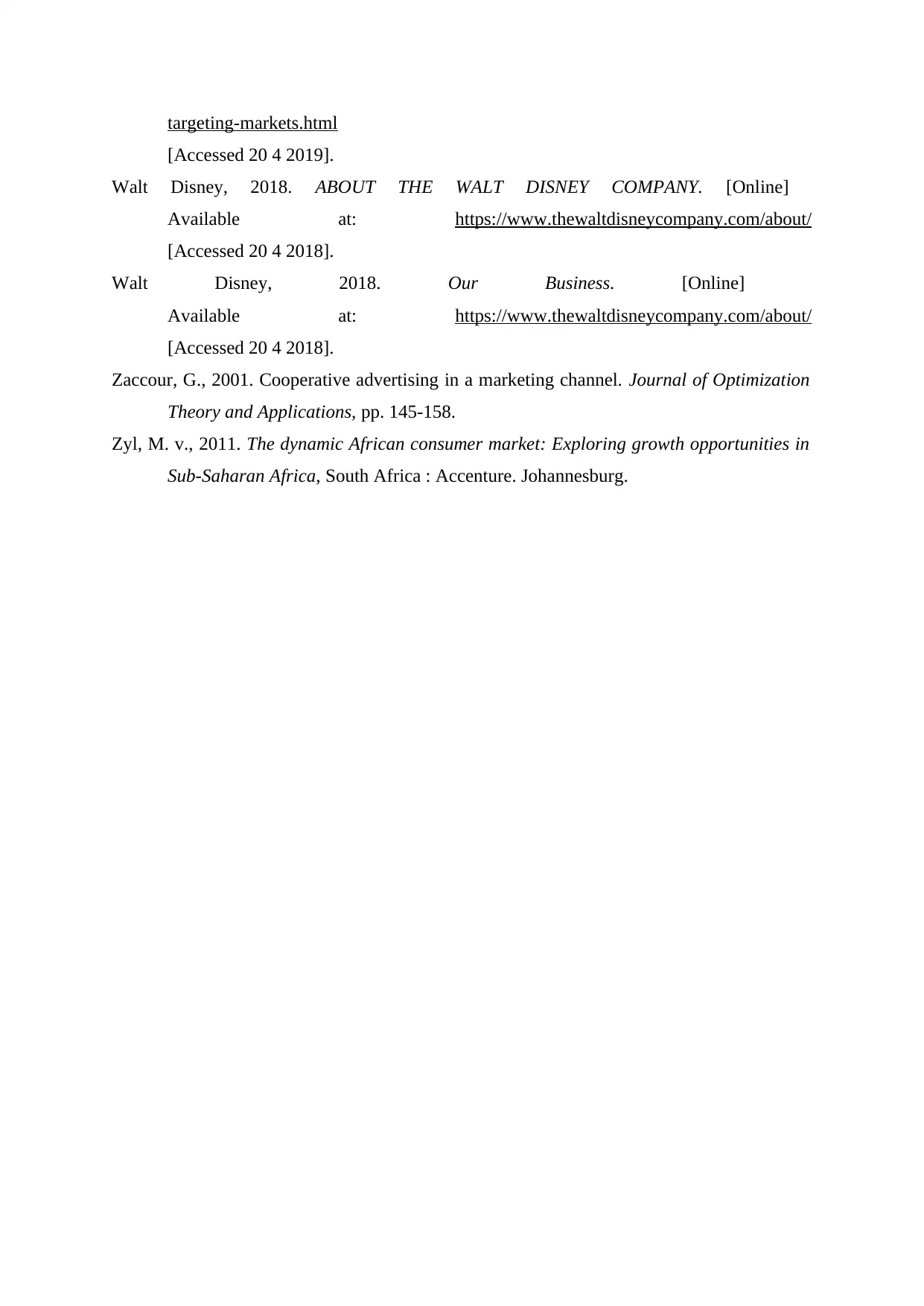
targeting-markets.html
[Accessed 20 4 2019].
Walt Disney, 2018. ABOUT THE WALT DISNEY COMPANY. [Online]
Available at: https://www.thewaltdisneycompany.com/about/
[Accessed 20 4 2018].
Walt Disney, 2018. Our Business. [Online]
Available at: https://www.thewaltdisneycompany.com/about/
[Accessed 20 4 2018].
Zaccour, G., 2001. Cooperative advertising in a marketing channel. Journal of Optimization
Theory and Applications, pp. 145-158.
Zyl, M. v., 2011. The dynamic African consumer market: Exploring growth opportunities in
Sub-Saharan Africa, South Africa : Accenture. Johannesburg.
[Accessed 20 4 2019].
Walt Disney, 2018. ABOUT THE WALT DISNEY COMPANY. [Online]
Available at: https://www.thewaltdisneycompany.com/about/
[Accessed 20 4 2018].
Walt Disney, 2018. Our Business. [Online]
Available at: https://www.thewaltdisneycompany.com/about/
[Accessed 20 4 2018].
Zaccour, G., 2001. Cooperative advertising in a marketing channel. Journal of Optimization
Theory and Applications, pp. 145-158.
Zyl, M. v., 2011. The dynamic African consumer market: Exploring growth opportunities in
Sub-Saharan Africa, South Africa : Accenture. Johannesburg.
1 out of 13
Related Documents
Your All-in-One AI-Powered Toolkit for Academic Success.
+13062052269
info@desklib.com
Available 24*7 on WhatsApp / Email
![[object Object]](/_next/static/media/star-bottom.7253800d.svg)
Unlock your academic potential
© 2024 | Zucol Services PVT LTD | All rights reserved.





